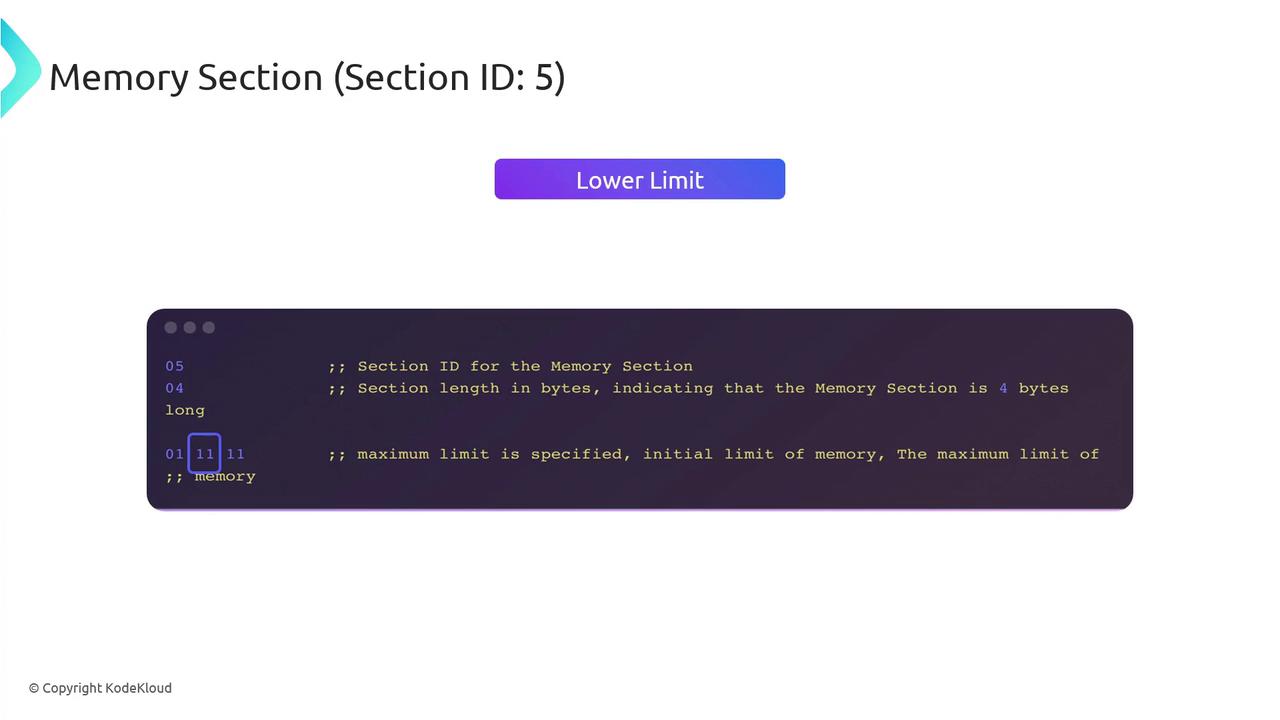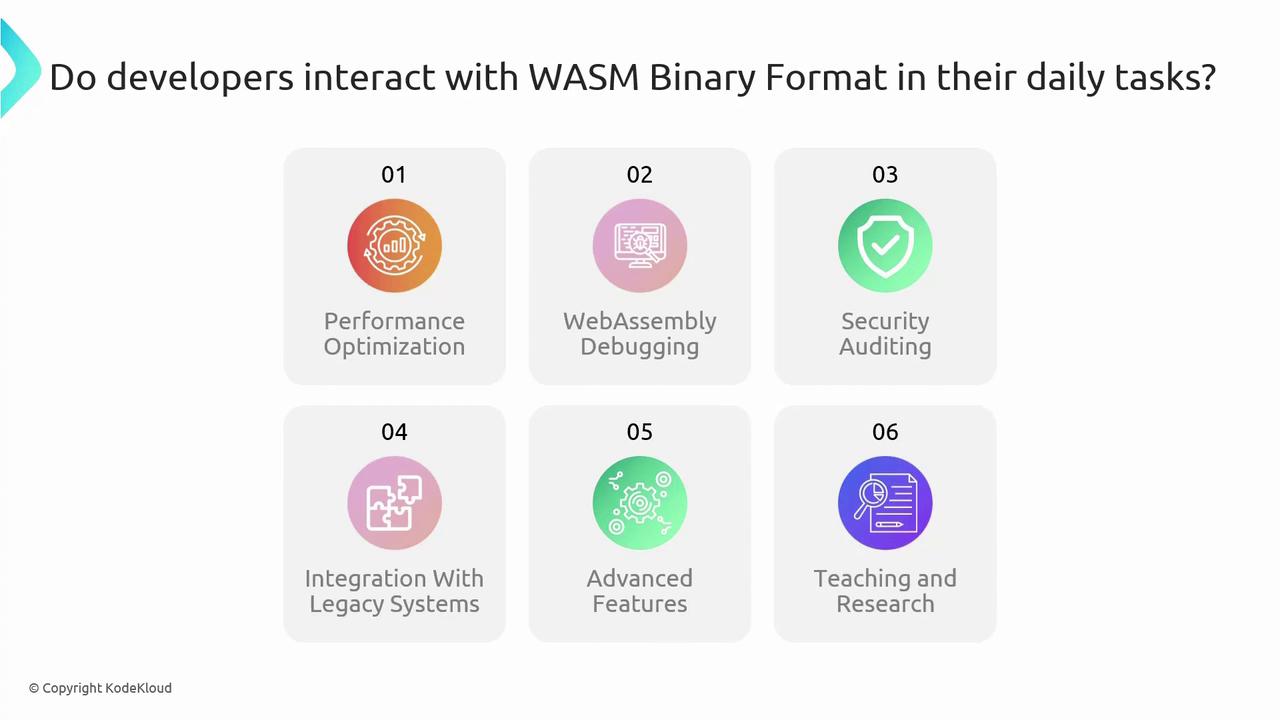Exploring WebAssembly (WASM)
Getting Started with WebAssembly
Understanding the WebAssembly Binary Format
WebAssembly (WASM) defines a portable, stack-based virtual machine in two primary formats:
- A compact binary format (
.wasm) - A human-readable text format (
.wat)
Designed as a universal compilation target for languages like C, C++, Rust, C#, Go, and Python, WASM enables high-performance web applications that approach native speed.
In this guide, we'll dissect the structure of a .wasm binary—examining each section, representative bytecode snippets, and how these modules load and execute in a runtime.
Compiling a C++ Program to WebAssembly
To analyze real-world binaries, let's compile a simple C++ “Hello, WebAssembly!” program. Ensure you have Emscripten installed:
Note
Make sure your Emscripten SDK installation is up to date and the emcc command is in your PATH.
// hello.cpp
#include <iostream>
int main() {
std::cout << "Hello, WebAssembly!" << std::endl;
return 0;
}
Run the compiler:
emcc hello.cpp -o hello.js
This produces hello.js (loader/JavaScript glue) and hello.wasm (binary module) for inspection.
Module Header: Magic Number & Version
Every WebAssembly binary starts with an 8-byte header:
00 61 73 6D ;; Magic number: "\0asm"
01 00 00 00 ;; Version: 1
- Magic number
0x00 0x61 0x73 0x6Didentifies the file as WebAssembly. - Version
0x01 0x00 0x00 0x00corresponds to the current WASM spec.
Section Layout
After the header, a .wasm file is organized into sequentially numbered sections. Each section has:
- A one-byte section ID
- A ULEB128-encoded section length
- A payload (raw bytes)
Below is a summary of standard sections:
| Section ID | Section | Purpose |
|---|---|---|
| 0 | Custom | Custom metadata, debug information |
| 1 | Type | Function signatures |
| 2 | Import | Imports (functions, memory, tables, globals) |
| 3 | Function | Function declarations (type indices) |
| 4 | Table | Tables of function references (for call_indirect) |
| 5 | Memory | Linear memory definitions (pages and limits) |
| 6 | Global | Module-level global variables |
| 7 | Export | Exports (functions, memory, tables, globals) |
| 8 | Start | Optional start function index |
| 9 | Element | Table initialization entries |
| 10 | Code | Function bodies (locals and opcodes) |
| 11 | Data | Data segment initializers |
We'll now explore the key sections in detail.
1. Type Section (ID 1)
Defines function signatures. Each entry begins with 0x60 (function type), followed by parameter and return types:
01 ;; Section ID: Type
0F ;; Section length: 15 bytes
02 ;; Number of types: 2
60 01 7F ;; Type 0: (i32) -> ()
60 02 7F ;; Type 1: (i32, i32) -> ()
0x7Fdenotesi32.- The leading
0x60indicates a function signature.
2. Import Section (ID 2)
Imports functions, memory, tables, or globals from the host environment:
02 ;; Section ID: Import
11 ;; Section length: 17 bytes
01 ;; Imports count: 1
03 65 6E 76 ;; Module name: "env" (length=3 + "env")
08 70 72 69 6E 74 5F 73 74 72 ;; Field name: "print_str" (length=8 + text)
00 ;; Import kind: Function
00 ;; Type index: 0
- Module and field names are length-prefixed UTF-8 strings.
- Import kind
0x00refers to a function.
3. Function Section (ID 3)
Lists the type index for each function defined in this module:
03 ;; Section ID: Function
05 ;; Section length: 5 bytes
04 ;; Number of functions: 4
00 01 10 02 ;; Type indices for each function
Each byte is a ULEB128-encoded index pointing into the Type Section.
4. Table Section (ID 4)
Specifies tables of function references, used by call_indirect:
04 ;; Section ID: Table
08 ;; Section length: 8 bytes
01 ;; Number of tables: 1
70 00 01 ;; Element type: anyfunc (0x70), flags=0 (no max), initial size=1
0x70=funcref.- Flags = 0 → only an initial size is provided.
5. Memory Section (ID 5)
Defines the module's linear memory (in 64 KiB pages).

05 ;; Section ID: Memory
03 ;; Section length: 3 bytes
01 ;; Number of memory blocks: 1
00 11 ;; Flags=0 (initial only), initial=17 pages (0x11)
- Flags=0 indicates only an initial limit.
- Limits are ULEB128-encoded page counts (1 page = 64 KiB).
6. Global Section (ID 6)
Declares module-level globals with type, mutability, and initialization:
06 ;; Section ID: Global
19 ;; Section length: 25 bytes
03 ;; Number of globals: 3
7F 01 ;; Global entry: i32, mutable
41 0B 0B ;; Init expr: i32.const 11; end
… ;; Additional globals…
7. Export Section (ID 7)
Exports functions, memory, tables, or globals to the host:
07 ;; Section ID: Export
0C ;; Section length: 12 bytes
01 ;; Number of exports: 1
04 6D 61 69 6E ;; Name: "main" (length=4)
00 ;; Export kind: Function
03 ;; Function index: 3
- Export kind codes:
0x00=Function,0x02=Memory, etc.
Additional Sections
- Start (ID 8): Designates an entrypoint function.
- Element (ID 9): Table initialization data.
- Code (ID 10): Function bodies (local variables + opcodes).
- Data (ID 11): Memory data segments.
- Custom (ID 0): Arbitrary metadata and debug info.
When to Dive into the Binary Format?
Inspecting raw bytecode isn't required for everyday WebAssembly development, but it shines in:

- Performance optimization
- Low-level debugging & inspection
- Security auditing & fuzzing
- Legacy system integration
- Custom features via custom sections
- Teaching, research, and compiler comparison
Note
Deep diving into the .wasm layout can help troubleshoot toolchain issues and squeeze out maximum performance.
Links and References
- WebAssembly Specification
- Emscripten Documentation
- MDN WebAssembly Guide
- Binaryen Toolkit
- Official WebAssembly Site
Watch Video
Watch video content